Sound, Waves And Vibration ~ Part II
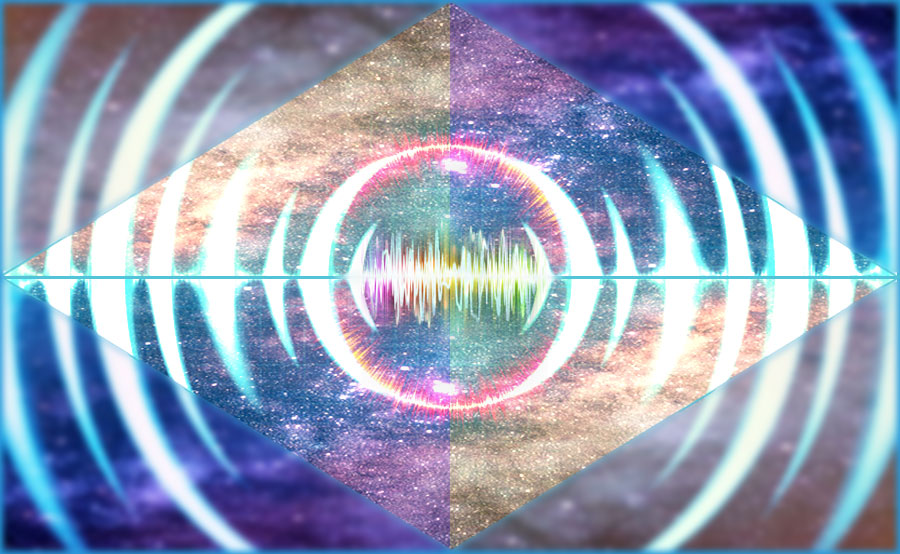 by Itzhak Bentov
by Itzhak Bentov
The Hologram
We have seen before that information can be stored by an interference pattern of waves. To have interference, we must have at least two interacting components, and here is how it is done (Fig. 11):
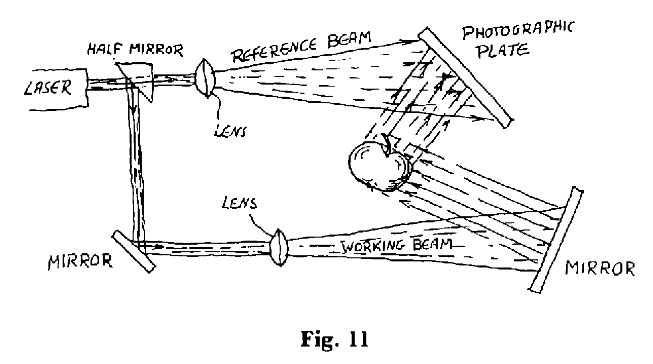 The laser light beam is split into two components by a half mirror, that is, a semi-transparent mirror. This allows part of the beam to continue undisturbed while part of it is deflected to another mirror. Both narrow beams are spread open by lenses. The upper beam, which we shall call the reference beam, arrives at a photographic plate after an event-less flight, since no event of note has occurred on its way to the plate. It proceeds then to deposit its imprint on the film.
The laser light beam is split into two components by a half mirror, that is, a semi-transparent mirror. This allows part of the beam to continue undisturbed while part of it is deflected to another mirror. Both narrow beams are spread open by lenses. The upper beam, which we shall call the reference beam, arrives at a photographic plate after an event-less flight, since no event of note has occurred on its way to the plate. It proceeds then to deposit its imprint on the film.
The other half of the beam we shall call the working beam. This beam’s trip had an event: It had encountered on its way an object, in this case an apple, that it had illuminated and with which it had interacted. (We don’t consider encounters through mirrors and lenses as worthwhile talking about.) The working beam will then be reflected from the apple and fall on the film. There it will meet its twin, the reference beam, and will tell it all about its experiences with the apple. (Neither of them suspect that their interaction is being recorded on film.) The interaction between the two beams will cause ripples to form between them, which will form the interference pattern we are already familiar with since the light waves will behave in this case the same way as do water waves. However, these ripples do not at all resemble the shape of the apple, but as we already know, the ripples in the photographic emulsion do contain information, and that information can be elicited from the film by illuminating the exposed film with the same light used in making the hologram. As we do that, we shall see the apple appear suspended in midair and looking very three-dimensional and real. We could be easily deceived, when viewing an image reconstructed from a hologram, that we were seeing the actual object.
Note that the important part of holographic image making is the interaction of a reference beam — a beam that is pure, virgin, and untouched — with a working beam, which has had some experiences in its life. The magnitude of these experiences is being measured against the reference beam, which serves as a baseline for comparison.
Our whole reality is constructed by constantly making such comparisons. Our senses, which describe our reality to us, are making these comparisons all the time. Unfortunately, our senses, having no absolute reference line, must generate their own relative reference line. But whenever we perceive something, we always perceive differences only.*
It would be useful to take one example from Nature to see how such differences are put to use in a very obvious way. Take the bat, for instance. We all know that this little mouse-like fellow lives on insects he catches in flight. Since he is active at night, he has developed a sonar-like device** that serves him very well and enables him to make a reasonably easy living.
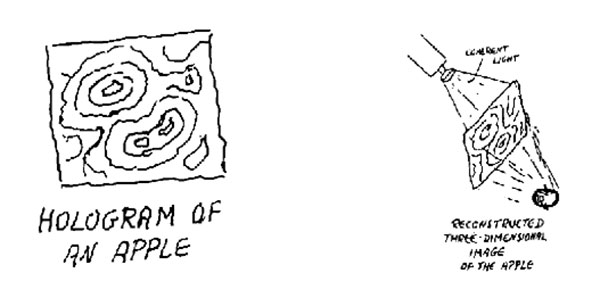
*Whether it be heat or cold, light or darkness, quiet or noise we always compare two relative quantities. We have no absolute measure of anything as far as our daily reality is concerned.
He has highly specialized structures in his head that allow him to emit a very high frequency sound and to direct it in a fairly narrow beam. This is his reference beam. As this beam encounters a flying insect, some of this sound will be reflected back to the bat (Fig. 12). He picks up this echo, or we can call it the working beam, and compares it to his original squeak or chirp. There will be a difference between the two (called the Doppler effect), and this difference tells the bat how far away the insect is and how fast it is flying, relative to him. As the bat successfully closes in on the insect, the difference between the two frequencies — the emitted frequency and the echo — diminishes. When it becomes very small, the bat opens its mouth and swallows the echo. Some echoes, as the bat surely knows, are tastier than others.
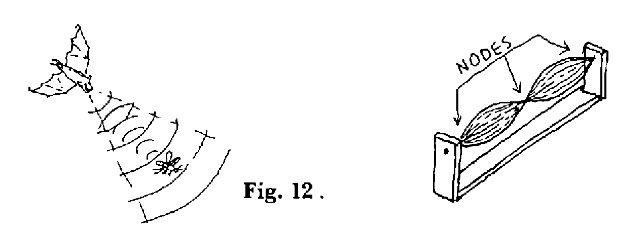
We see now that by appreciating the difference between two sounds or vibrations, one can get along quite well in life. There are many creatures that make a living by appreciating differences in sound: porpoises, whales, and many others. We humans also utilize this technique in less obvious ways in color vision, hearing, etc.
**Sonar: an underwater sound-detection device.
Oscillators And Resonant Systems
We may describe an oscillator as any object that moves in a regular, periodic manner. We may call a vibrating string an oscillator, or a weight hanging from a spring, or a pendulum — anything that performs a repetitive, periodic movement, that is, vibrates. We may generalize and say that oscillators produce a sound or a note, whether audible or not, as long as they alter their environment in a periodic manner. That environment may be tissue, as in the heart aorta oscillating system, water, air, electrical fields, gravitational fields, or anything else.
Suppose we tune two violins, then put one of them on the table and play a note on the other. If we watch carefully, we shall see that the same string that we are playing on one violin is also humming on the violin that we placed on the table. Clearly, there is a “sympathetic resonance” between the two. Let us analyze what is happening.
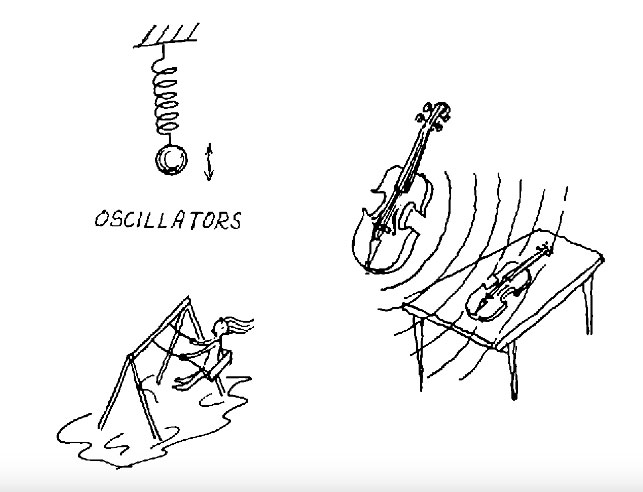
When we draw the bow over a string, it vibrates at its own natural frequency, which we call self-frequency. Since the two violins are correctly tuned, we know that the natural frequencies of both strings were identical. Within a system like this (we shall call the two violins a “system”), it is very easy to transfer energy. In this case, we are talking about acoustical energy. The air waves generated by the first violin impinge on the second violin. The string that is tuned to the emitted note will absorb the energy of the waves of that frequency preferentially because that energy comes to it at its own natural frequency. The energy transfer within this system is therefore optimum, and such a system, made up of two tuned oscillators, is called a resonant system.
Let us take another example. Suppose we get several old fashioned pendulum-type grandfather clocks. Let us hang them on a wall and arrange their pendulums so that they will start out beating each at a different angle, that is, out of phase with each other. In a day or two, we shall find that all the pendulums are beating in phase, as if locked together. (Pendulum length should be the same for all of them.) Here we see that the tiny amount of energy that was transmitted through the wall from clock to clock was sufficient to bring them into phase with each other. If we disturb one of the clocks, it will get locked into rhythm quite fast. The larger the number of oscillators within such a system, the more stable the system, and the more difficult it is to disturb. It will force a wayward oscillator back into line very quickly.
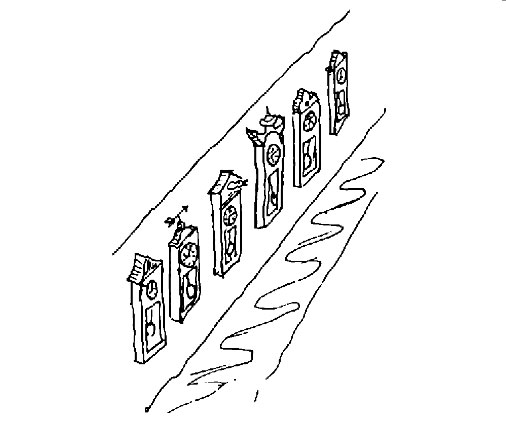
The Sound Of The Body
The heart is a big noisemaker. We can easily check this by putting our ear on someone’s chest and listening to it. Each beat shakes the whole body, and the body has a typical response to this beat, which is quite easily measured. Figure 13 shows what such motion looks like when measured with a sensitive seismograph-like instrument.* This movement is clearly related to the heart beat; in fact, the largest peak we see in this graph is caused by the ejection of blood from the heart’s left ventricle. The portion between the large peaks looks fairly irregular and is caused by the vibration of the body due to the action of the blood in the aorta, which is the largest artery in our body. This irregular portion is due to a destructive interference pattern set up in the aorta, as will be shown later.
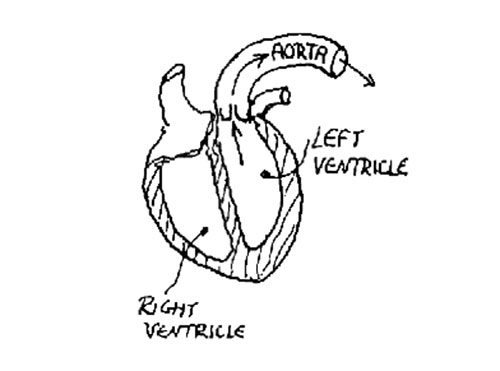
When we stop breathing, the irregular signal in Figure 13 turns into a nice, regular, practically sine-wave pattern (Figure 14). This is surprising, and when we look into the reasons for this behavior, we find that the heart-aorta system has become a so-called resonant system, as shown in Figure 15, in which the length of the aorta forms one-half a wavelength of this system. By resonant system we mean that it resonates just like a tuned musical instrument.

*A seismograph is an instrument used to measure tremors of the earth’s crust during earthquakes.
Here is what seems to be the case: When the left ventricle of the heart ejects blood, the aorta, being elastic, balloons out just beyond the valve and causes a pressure pulse to travel down along the aorta (Fig. 16). When the pressure pulse reaches the bifurcation in the lower abdomen (which is where the aorta forks in two to go into the legs), part of the pressure pulse rebounds and starts traveling up the aorta. If in the meantime the heart ejects more blood, and a new pressure pulse is traveling down, these two pressure fronts will eventually collide somewhere along the aorta and produce an interference pattern. This is reflected in the movement of the body and is the reason for the irregular pattern of body motion in Figure 13.
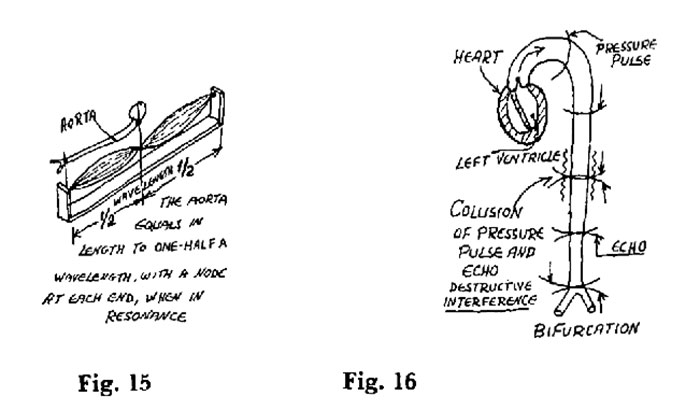
However, when the breathing stops, it looks as if some communication has been set up between the heart and the bifurcation. Some kind of a signal seems to travel from the bifurcation to the heart, saying to it: “Heart, ‘hold it.’ Hold your next pulse until the echo from the bifurcation returns to you — only then should you eject the next quantity of blood.” When this happens, and the echo and pulse move out of the heart together, and they continue to move up and down in synchrony, then such a system is said to be in resonance. It causes the body to move harmoniously up and down about, seven times a second, hence the nice, regular, large amplitude sine wave pattern in Figure 14. The amplitude or height of this signal is about three times the average of the normal signal. Another characteristic of resonant behavior is that it requires for its sustenance a minimum amount of energy.
Well, but how long can we hold our breath? Certainly, not over a minute or so comfortably, and so we start breathing and ruin the nice rhythmic pattern. Let us not forget now that our body includes our head, and inside the skull, carefully packaged, is a very delicate instrument: the brain. This brain is cushioned by a thin layer of fluid and is wrapped in a tight bag, the dura. About the simplest way to visualize this system is to have a relatively soft, round fruit, such as a peach, enclosed in a can containing a heavy syrup. If we shake the can, we find that the peach will hit the top and the bottom of the can and be accelerated with a small delay in the direction in which the can is moving. This movement is quite small, only .005 to .010 mm. This is exactly what happens to the brain.
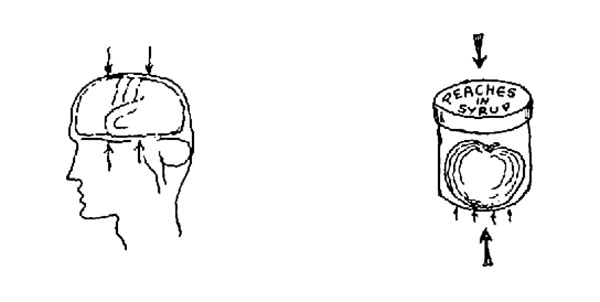
The question is: How come we are not aware of this happening to us? It’s probably because when something is happening to the nervous system for an extended period of time, and that event is not traumatic, it will not be brought to our conscious attention because the portion of the brain that is in charge of censoring and separating meaningful signals from unmeaningful ones will relegate it to the heap of unimportant signals, which require no conscious processing. We know from experience that we can easily get used to and disregard the loud ticking of a clock next to us or the noise in the cabin of an airplane.
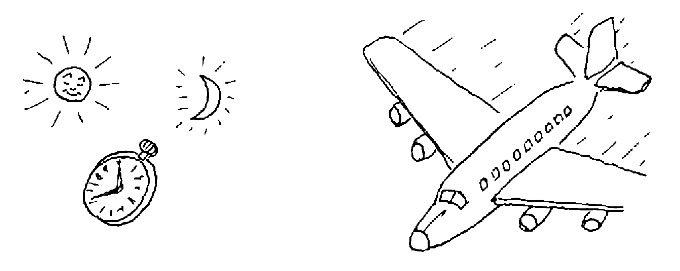
Rhythm Entrainment
Suppose we go out on a balmy summer evening and notice some fireflies settling in a bush, blinking off and on. At first, this blinking is random, but fairly soon we notice that an order is slowly developing. After a while, we see that the fireflies in the whole bush are blinking on and off in unison. This phenomenon is called rhythm entrainment. It seems that nature finds it more economical in terms of energy to have periodic events that are close enough in frequency to occur in phase or in step with each other. That is the meaning of rhythm entrainment.
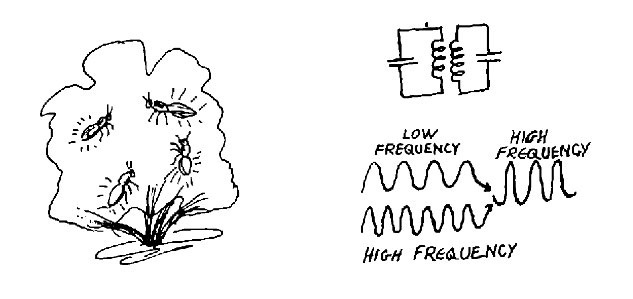
Let us take another example. When electronic circuits are built so that they contain oscillators (of electronic type common in radio or TV circuits) that happen to oscillate in frequencies that are close enough to each other, there will be a tendency of the oscillators to get locked in step with each other and oscillate at the frequency of one of them. Usually, it is the fastest oscillator that will force the slower ones to operate at this pace. Here again, Nature feels that it is more economical if two or any number of oscillators that vibrate at frequencies close enough to each other work together rather than insist on keeping their small differences.
Major effects of rhythm entrainment occur in Nature. Our biological rhythms are entrained by light and to a certain extent by gravitational effects. These are the two most obvious factors. However, magnetic, electromagnetic, atmospheric, and subtle geophysical effects influence us in ways that are not presently well understood. We usually get up with daylight and go to sleep at night. The sleep-wake cycles of animals and birds are more strongly tied to the light-dark cycle than those of our “civilized” humanity because we have developed artificial sources of light and can change our light-dark cycle at will. However, we all know that when our light-dark cycle, which runs our biological clocks, is drastically altered, as when we take a long jet flight in an east-west direction and cross several time zones, such an interference with our biorhythm has quite a marked effect on our ability to function in the new environment for a day or two.
An interesting experiment was performed by Professor Frank Brown, Jr., of Northwestern University, Evanston, Illinois.* In order to check out what factors influence the biorhythm of animals, he had some live oysters shipped to his lab from the Long Island Sound, a distance of about a thousand miles in a east-west direction. These oysters open and close their valve in rhythm with the tides. The animals were shipped in tight opaque containers filled with sea water. Upon arrival, they were stored in a lab with no natural daylight. On first examination, the oysters, geared to the rhythm of tides in the Long Island Sound, kept opening and closing their valves. In about two weeks, they started shifting their rhythm, and a while later, they stabilized in a rhythm that coincided with the passage of the moon over Evanston, Illinois. In this case, we may assume that the oysters are indeed rhythm-entrained by the gravitational effects of the moon.
*Gauquelin, Michel. The Cosmic Clocks. Chicago: Regnery, 1974; London: Peter Owen, 1969.
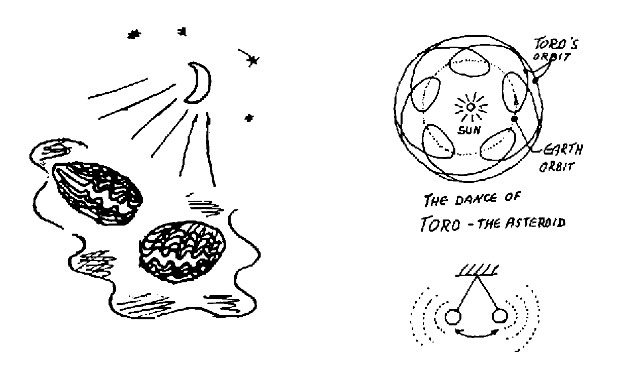
However, it is not only we, the tiny creatures of this planet, who are rhythm-entrained. The big and mighty asteroids and the planets themselves are rhythm-entrained and develop resonances in their orbits as they rotate about the sun. Asteroids, which are minor planets, will not only respond to the gravitational pull of the sun but will also be strongly affected by the gravitational fields of the major planets. They must dance, so to speak, to the tune of two masters, and so the asteroids develop little dances to the music of the spheres in which they pay tribute to the forces involved. They go into resonant orbits and describe minor loops around the planets within their major loop around the sun.
All the phenomena described here are of a periodic, repetitive nature. We have made a generalization at the beginning, saying that when such a rhythmic movement occurs, it affects its environment, whether that environment is air, water, solids, electromagnetic or gravitational fields. In the case of air, water, or a solid, these vibrations will affect our near environment only and can be called “sound.” If we shake our electromagnetic or gravitational fields, the disturbance in the environment will travel faster and farther. We will still apply the word “sound” to it, although it will be a sound of a different kind since it would travel at the velocity of light. We could actually associate our whole reality with sound of one kind or another because our reality is a vibratory reality, and there is nothing static in it. Starting with the nucleus of an atom, which vibrates at enormous rates, the electrons and the molecules are all associated with characteristic vibratory rates. A most important aspect of matter is vibratory energy.
When we think, our brains produce rhythmic electric currents. With their magnetic components, they spread out into space at the velocity of light, as do the electric waves or sounds produced by our hearts. They all mingle to form enormous interference patterns, spreading out and away from the planet.
They are admittedly weak, but they are there. The more finely our systems are tuned, the clearer a signal we can pick out of the general noise and jumble of “sounds.” When we have a system of tuned oscillators, even the tiniest signal can be picked up. You may recall that it requires very little energy of the correct frequency to drive a resonant system. Our planet itself is producing shock waves in the plasma* that fills the solar system.
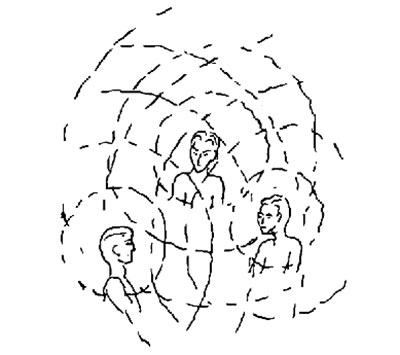
These shock waves interact with those caused by other planets and produce resonances between the planets and the asteroids. In short, our whole reality is based on one common factor, and that is periodic change, or sound. Our senses are geared to respond to all these different “sounds,” but we are always comparing one sound with another. We can appreciate only the differences in sound.
*Plasma refers here to a tenuous gas containing charged particles.
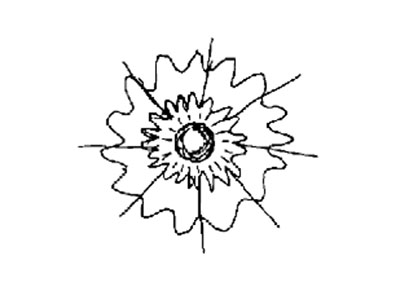
Summary
We have seen various ways of producing sound. We know that when a string or any other structure vibrates, it may develop standing waves. These are waves that occupy a “fixed” position in any structure, whether it is a string, a plate, a container filled with a liquid, or a blood vessel.
Nodes are the spots in which minimum motion occurs.
When sets of waves are superposed, interference patterns result.
A hologram is an interference pattern of light waves on a photographic plate.
When two differing frequencies are superposed, beat frequencies result.
Coherency is an in-step or in-phase behavior of waves.
Oscillators are devices that move in a periodic, repetitive fashion between two points of rest. Our bodies are also such devices.
Oscillators vibrating out of phase with each other may get locked into phase with each other through rhythm entrainment.
A system of oscillators that is in phase can resonate.
Our reality is a vibratory reality, filled by “sounds” of different kinds.
We respond to differences in these sounds.
Excerpt from Stalking The Wild Pendulum
See Part I here.
Posted in Other Topics, Science For The New Agewith 1 comment.


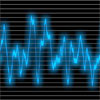
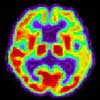
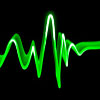
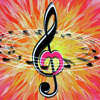
I Love you Guys So Much!!!
NAMASTE!